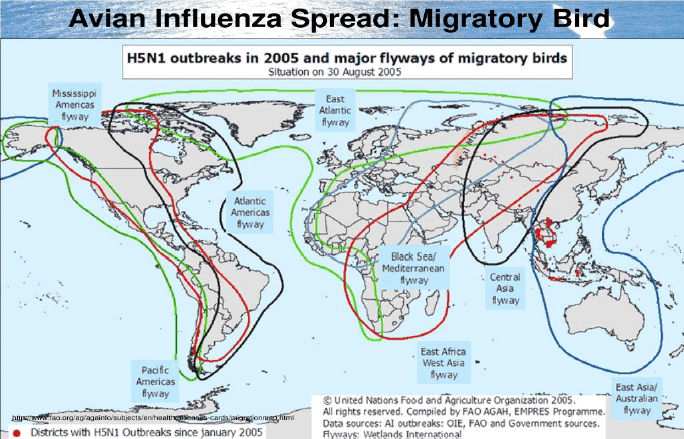Scottish wild bird highly pathogenic avian influenza response plan
This document sets out the approach that the Scottish Government and its agencies will take to respond to an outbreak of Highly Pathogenic Avian Influenza (HPAI) in wild birds in Scotland.
Pathogen and routes of incursion for avian influenza
Disease
17. Avian influenza refers to the disease caused by infection with avian influenza Type A viruses. These viruses naturally spread among wild birds worldwide and can infect domestic poultry and other captive birds.
18. There are four types of influenza viruses: types A, B, C and D with some strains of Influenza type A viruses of most significance to public health. Influenza type A viruses are classified into subtypes according to the combinations of different virus surface proteins hemagglutinin (HA) and neuraminidase (NA). There are 16 different H proteins and 9 N proteins in influenza affecting birds. The H5 and H7 are considered to be the most important from an animal health perspective, as they are the only subtypes to have been identified as causing highly pathogenic infection in birds. However, there are five strains of avian influenza that have caused public health concern in recent years: H7N9, H9N2, H5N6, H5N8 and a type of H5N1 strain more common in Asia. None of these strains easily infect people and are not usually spread from human to human, however a small number of people have been infected around the world and so precautionary steps are taken to mitigate this risk as much as possible.
19. The clinical severity as a result of avian influenza virus infection varies dependent upon both species infected and virus strain.
20. There are many strains of avian influenza viruses, which vary both in their ability to cause disease in birds and their ability to infect humans and other mammals.
21. The 2021/22 outbreak was sequenced by the UK's National Reference Laboratory for avian influenza at Weybridge (see roles and responsibilities for more details) as being H5N1 strain that has a low mammalian affinity.
22. Avian influenza is a notifiable animal disease in poultry and other captive birds (not wild birds). If you suspect any type of avian influenza in poultry or captive birds you must report it immediately by contacting:
- If in Scotland your local Animal and Plant Health Agency (APHA) Field Services Office.
- If in England call the Defra Rural Services Helpline on 03000 200 301.
- If in Wales, contact 0300 303 8268.
- Failure to do so is an offence.
23. Avian influenza is not a notifiable disease in wild birds. However, members of the public should use the online reporting system or call the Defra helpline (03459 33 55 77) if they find dead wild birds. See contact information at the end of this document for further details.
Routes of incursion
24. Avian influenza can be spread in a number of ways:
- Movement of infected birds, from bird-to-bird, by contact with contaminated body fluids and faeces.
- Movement of contaminated objects and surfaces.
- Ingestion of infectious material.
25. An avian influenza outbreak can occur at any point in the year. However, avian influenza is not endemic in poultry in the UK, rather the UK typically faces a seasonal increase in the risk of an avian influenza incursion associated with the winter migration patterns of wild birds to the UK. Recent HPAI incursions in wild birds in the UK have followed migratory patterns of mainly Anatidae (ducks, geese and swans), which means infections are typically reported between autumn and spring. However, the recent and unprecedented spread of infections in Charadriiformes (shore birds) and Suliformes (orders of seabird species) have elongated the infection timeframe extending into late summer.
26. In late autumn or early winter, wild migratory wildfowl have the potential to carry the HPAI infection to the UK. In contrast, the risk of avian influenza incursion during the summer typically decreases because environmental conditions (warm, dry, high UV exposure) can reduce virus survival in the environment.
27. The UK is at the centre of a number of bird migration flyways (see figure 1). This represents challenges when trying to model potential transmission routes. The main flyways for migrating birds to and from the UK are:
- Greenland/Iceland/ North West Atlantic,
- North East Arctic archipelagos
- Feno/Scandinavia
- Continental Europe
- South Atlantic

28. As part of the work by the Scottish Avian Influenza task force, the potential for environmental testing to determine presence of the virus is being considered given the prevalence of the 21/22 outbreak during the summer months (see Research and Monitoring section).
29. The main clinical signs of HPAI in birds are listed in Annex B, and can be found online at: https://www.gov.scot/publications/avian-influenza-bird-flu/pages/how-to-control-the-disease/
Contact
Email: marine_species@gov.scot
There is a problem
Thanks for your feedback